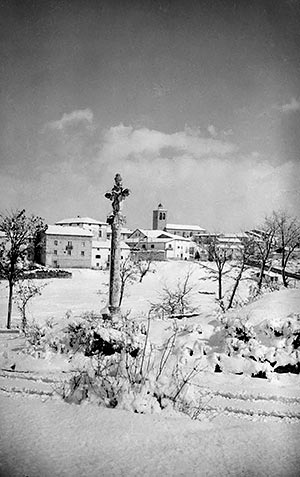Cultural heritage of Ororbia
Introduction
Ororbia, capital of the cendea of Olza, barely ten kilometers from Pamplona, is a town in which traces of a rich past coexist with an important industrial development . It is not easy to establish its origin, due to the absence -for the moment- of archaeological remains. The first documentary evidence dates back to 1043, when King García Sánchez III "el de Nájera" donated the town and its church to the nobleman Sancho Fortuniones, who shortly afterwards ceded it to the monastery of Leire. If we look at the magnitude and quality of the projects carried out, the periods of greatest splendor of Ororbia were the first decades of the 14th century, when the church was built and decorated with artists from the cloister work of the cathedral of Pamplona, and the Renaissance, when the main altarpiece, the Wayside Cross and possibly the bridge over the Arga River were built.
The Ororbieses, aware of the imposing heritage bequest that houses the village, have not hesitated to invest in their study, restoration and conservation a part of the benefits of economic growth experienced in recent years. They have intervened in works of art of the highest level, such as the church, its main altarpiece and the mural paintings discovered behind it -with the partnership of the Government of Navarre and the archbishopric-, but also in more modest manifestations loaded with value for the local history, such as the source and the washing place, the tajadera of the irrigation channel or a bridge of the old road to Pamplona. In the field of documentary heritage, the council's file has been organized. In addition, several books have been published in order to revalue and disseminate the history and heritage of the town.
The most recent interventions undertaken by the Council of Ororbia have been the restoration of the Wayside Cross located next to the bridge, and of the baptismal font and the canvases of St. John the Baptist and St. Francis Xavier in the church of St. Julian. The baptismal font and its Gothic capital are of special interest, since the cleaning has made visible several figurative scenes that until now were barely visible.
The extension of the Arga River Park in 2021, which reaches Ororbia through an impressive single-span wooden footbridge, offers a good opportunity to visit the town and enjoy the hospitality of its inhabitants. This pathway is a proposal to walk through its streets and discover the most unique and significant places of its millenary past.
ALEGRÍA SUESCUN, D., Flour Mills of Ororbia. Historical-documental study, Concejo de Ororbia, 2015.
GUIJARRO SALVADOR, P., Ororbia: a thousand years of history, Concejo de Ororbia, Kybse, 2015.
MARTÍNEZ ÁLAVA, C. J., TARIFA CASTILLA, M.ª J. and LATORRE ZUBIRI, J., La iglesia de San Julián de Ororbia. History and restoration, Concejo de Ororbia. Foundation for the Conservation of the Historical Heritage of Navarre. Graftech Ibérica, 2014.
ZUBIAUR CARREÑO, F. J., "Catalog de miradas. La Navarra que fotografió Nicolás Ardanaz", in Ricardo Fernández Gracia (coord.), Pvlchrvm: Scripta varia in honorem M.ª Concepción García Gainza, Gobierno de Navarra. University of Navarra, 2011, pp. 838-846.
transcript del Asilo San José: file Contemporáneo de Navarra/Vivienda/1116846.











